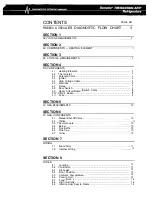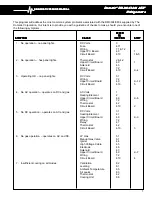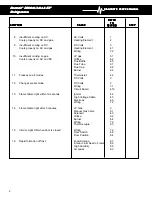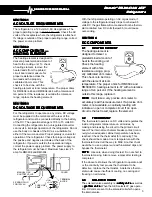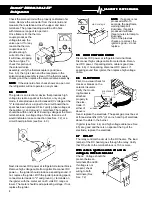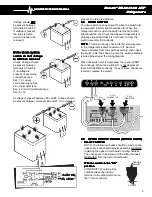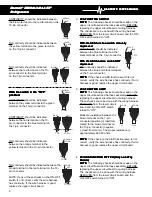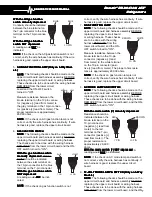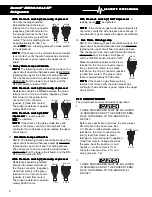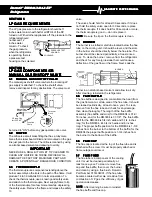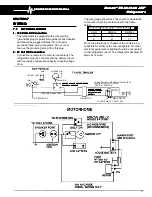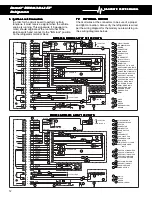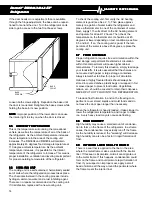
9
DIAGNOSTIC SERVICE MANUAL
DIAGNOSTIC SERVICE MANUAL
DIAGNOSTIC SERVICE MANUAL
DIAGNOSTIC SERVICE MANUAL
DIAGNOSTIC SERVICE MANUAL
Dometic
Dometic
Dometic
Dometic
Dometic
®
®
®
®
®
RM3604/3804 AES
RM3604/3804 AES
RM3604/3804 AES
RM3604/3804 AES
RM3604/3804 AES
®
®
®
®
®
Refrigerators
Refrigerators
Refrigerators
Refrigerators
Refrigerators
For AC heating element operation, check that voltage
is present between the large black and large white
wire at the circuit board. If voltage is below 100 volts,
the circuit board will select another mode. If voltage
is above 100 volts, check that AC volts are present at
the heating element connection. If no voltage is
present, change the circuit board.
NOTE: Before installing a new circuit board, correct
the cause of the failure, most likely it is the heating
element (see Sec. 2.1) or wiring (see Sec. 7.2).
If voltage is present, DO NOT CHANGE THE CIR-
CUIT BOARD. Check the following components:
heating element (see Sec. 2.1), upper circuit board
(see Sec. 4.9 #2 to 4.9 #5 and 4.9 #8), thermostat
(see Sec. 4.2) and wiring (see Sec. 7.2).
3.
THESE PROCEDURES MUST BE FOLLOWED
IN SEQUENCE AND AT THE PROPER TERMI-
NALS OR DAMAGE TO THE BOARD WILL
RESULT.
For DC heating element operation, first check the
IGN lock terminal for a voltage reading of more than
4 volts. If voltage is below 4 volts, correct wiring
problem (see Sec. 7.1). If voltage is 4 or more, next
check voltage between the positive (+) and negative
(–) terminals on the main terminal block. If voltage is
below 13.3 (plus or minus [±] .3 volts), the DC
heating element will not be energized, the circuit
board will select gas mode; correct the power source
problem. If voltage is above 13.6 and IGN
lock terminal is receiving more than 4 volts,
verify the IGN lock voltage is reaching the
circuit board by checking the black terminal
on the 6-pin connector. If no voltage is
present, correct wire and or connection. If
voltage is present, next verify the voltage is
reaching the circuit board by checking
between the yellow terminal on the 6-pin
connector (positive [+] lead from meter) to
the grounding strip (negative [–] lead from the meter).
If no voltage is present, check the fuse (see Section
4.11). If voltage is present but BELOW
13.6, correct the wire and/or connection
problem. If voltage is ABOVE 13.6, check
for voltage between the red terminal on
the 6-pin connector (positive [+] lead from
meter) and the grounding strip (negative
[–] lead from meter). If no voltage is
present, replace the circuit board. If
voltage is present, the circuit board is
NOT defective, do not replace.
BLACK
6 Pin
RED
6 Pin
4.
THESE PROCEDURES MUST BE FOLLOWED IN
SEQUENCE AND AT THE PROPER TERMINALS OR
DAMAGE TO THE BOARD WILL RESULT.
Before you check the circuit board for gas operation,
verify these components are good:
Igniter
Igniter
Igniter
Igniter
Igniter (Sec. 4.4)
High Voltage Cable
High Voltage Cable
High Voltage Cable
High Voltage Cable
High Voltage Cable (Sec. 4.5)
Electrode
Electrode
Electrode
Electrode
Electrode (Sec. 4.6)
Solenoid
Solenoid
Solenoid
Solenoid
Solenoid (Sec. 4.7)
Upper Circuit Board
Upper Circuit Board
Upper Circuit Board
Upper Circuit Board
Upper Circuit Board (Sec. 4.9)
Thermostat
Thermostat
Thermostat
Thermostat
Thermostat (Sec. 4.2)
Also be sure NO voltage is present at the IGN lock
terminal, and delay mode is not activated. First,
check that voltage in excess of 10.5 volts is between
the yellow terminal on the 6-pin connector (positive
[+] lead from meter) to the ground strip (negative [–]
lead from meter). If less than 10.5 volts,
correct wiring and/or power source prob-
lem.
Next, check for the pulse voltage from the
igniter at the orange terminal on the 6-pin
connector (negative [–] lead from meter)
and the ground strip (positive [+] lead from
meter). If there is no signal voltage, check
the igniter (see Sec. 4.4) and the orange
wire and connections. If signal voltage is
present, next check for voltage on the
solenoid wires at the circuit board. Posi-
tive lead from meter to the gray wire and
negative lead from the meter to the black
wire. If voltage is 9.5 volts or more, the
circuit board is good. Do not replace. If no
voltage is present, replace the circuit
board.
5.
THESE PROCEDURES MUST BE FOLLOWED IN
SEQUENCE AND AT THE PROPER TERMINALS OR
DAMAGE TO THE BOARD WILL RESULT.
This check is to determine if the circuit board is
providing voltage to the upper circuit board. Measure
between the brown terminal on the
10-pin connector (positive [+] lead
from meter) to the blue terminal on
the 7-pin connector (negative [–]
lead from meter). A voltage reading
indicates the circuit board is good. If
no voltage is present, replace the
circuit board. NOTE
NOTE
NOTE
NOTE
NOTE: Before chang-
ing the circuit board, be sure all
troubleshooting steps have been followed.
4.11
4.11
4.11
4.11
4.11 FUSE
FUSE
FUSE
FUSE
FUSE
The fuse is to protect the circuit board. To check the
fuse, remove it from the holder and do a continuity
check. If no continuity, replace it with a proper 3 amp
time delay fuse.
YELLOW
6 Pin
ORANGE
6 Pin
BROWN
BLUE
10 Pin
7 Pin


